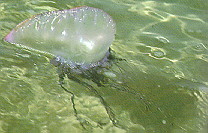Many people are probably familiar with the Portuguese Man-o-War. That’s the floating ocean animal that looks like an inflated plastic bag attached to long purple and blue tentacles. Oh, and those tentacles will deliver a nasty sting if you touch them! It is often called a Man-o-War jellyfish.
Interestingly, the Man-o-War (named because its upper section looks a bit like an old ship with its sail up) is not actually a jellyfish. However, it is closely related. True jellyfish are in the group of animals in the class Scyphozoa. Man-o-War are in the class Hydrozoa. They are all in the same phylum (Cnidaria), and all contain stinging cells (along with corals and anemones). The man-o-war is made up of different groups of animals, each of which has a particular role in the colony. The inflated float is formed by one. The long tentacles’ job is to sting and capture prey. The prey is digested by a third group. Another group of animals specializes in reproduction.
People should not underestimate those stinging tentacles. They can perform their function even if the animal is dead. The mechanical action of picking up the tentacle can cause the stinging cells to fire. This is why it is important to be cautious about handling the Portuguese Man-o-War, even if it is dried up on the beach. In the water, the tentacles sometimes become separated from the float. Even if still attached, they can be quite long—from 30 to perhaps more than 150 feet! So it is wise to give a good distance between you and a floating Man-o-War.
Floating sea snails?
 One thing that people may not know about is that the Man-o-War has an associated community of animals that live with it in the open ocean. This community includes sea snails—both the shell and animal of which are purple in color. These purple sea snails are able to create a bubble raft, which they use to float at the water’s surface. They feed on the Man-o-War and some of the other floating community members, including the two described below.
One thing that people may not know about is that the Man-o-War has an associated community of animals that live with it in the open ocean. This community includes sea snails—both the shell and animal of which are purple in color. These purple sea snails are able to create a bubble raft, which they use to float at the water’s surface. They feed on the Man-o-War and some of the other floating community members, including the two described below.
By-the wind sailors and blue buttons
The by-the-wind sailor is another hydrozoan in the man-o-war community. It consists of an oval membrane which has a triangular sail projecting above it. The blue/purple animal is attached to the bottom of the oval. This animal is usually less than two inches in length and the tentacles are quite short. The third hydrozoan in the group is similar to the by-the-wind sailor, but is circular and does not have a sail. It is called blue buttons.
 The membrane part of the animal floats, while the tentacles are below the water’s surface where they can encounter plankton to feed on. Both the by-the-wind sailor and blue buttons can sometimes be found washed up on beaches along with the man-o-war. Once the blue animal has died, the remaining clear membrane is quite difficult to find. Unlike the man-o-war, the stinging cells of these two hydrozoans are not powerful enough to affect us.
The membrane part of the animal floats, while the tentacles are below the water’s surface where they can encounter plankton to feed on. Both the by-the-wind sailor and blue buttons can sometimes be found washed up on beaches along with the man-o-war. Once the blue animal has died, the remaining clear membrane is quite difficult to find. Unlike the man-o-war, the stinging cells of these two hydrozoans are not powerful enough to affect us.
Blue sea slug
The three hydrozoans are also eaten by a sea slug which uses the surface tension of the water as the surface for it to crawl over. A gas-filled sac inside its body helps keep the slug at the ocean’s surface, upside down. This blue sea slug incorporates the stinging cells of the hydrozoans into the finger-like projections along its back. This provides the slug with some protection, and people should be cautious if handling it. This small blue slug can look like a blob of blue jelly washed up on the beach. At its largest, this slug is just over an inch in length.
Man-o-war fish
The final member of the man-o-war community is a fish. This is, not surprisingly, called the man-o-war fish. It is mostly silver in color, with blackish-blue spots and patches. It feeds on some of the man-o-war’s smaller tentacles. National Geographic has a short video showing several of these amazing animals.
 0
0
